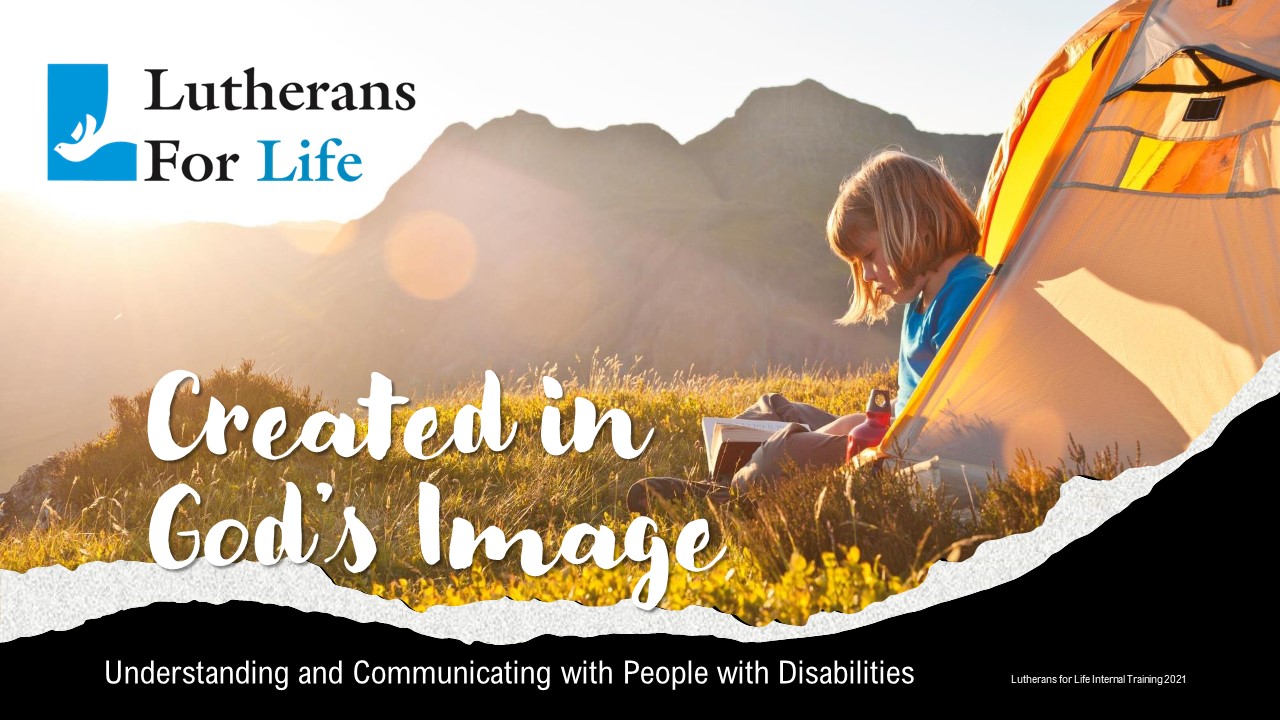
Detail:
This workshop was recorded September 1, 2021, during a Lutherans For Life staff retreat in Branson, Missouri, and is intended for use by LFL staff and the LFL Frontline.
Download Understanding and Communicating with People with Disabilities (PDF)
Download Understanding and Communicating with People with Disabilities (PowerPoint)
Defining Disabilities
The Americans with Disabilities Act defines a person with disabilities as a person who has a physical or mental impairment that substantially limits one or more major life activities. According to the U.S. Census, one in five have a disability.
Defining Developmental Disabilities
The Federal Developmental Disabilities Act defines developmental disabilities as:
- a mental or physical impairment or combination of both
- occurs prior to age 22 (disabilities occur during a person’s developmental years)
- continues indefinitely (recovery from an accident or illness does not qualify)
- results in substantial functional limitation in three or more of the following areasin major life activity:
- self-care
- receptive and expressive language
- learning
- mobility
- self-direction
- capacity for independent living
- economic self-sufficiency
- reflects the need for lifelong assistance and support that is planned and coordinated for the individual
Defining Intellectual Disabilities
An intellectual disability is a developmental disability. According to the American Association on Intellectual and Developmental Disabilities, it is a significant limitation in both intellectual functioning and adaptive behavior. Generally, this is an I.Q. below 75 and must have occurred prior to age 18. Support is needed in most of the following examples:
- learning, reasoning, problem solving, language, literacy, money, time, self-direction, interpersonal skills, self-esteem, avoid being victimized, daily living and personal care, occupational skills, travel, transportation, schedules, safety
The most common causes of a developmental disability are Down syndrome, Fetal Alcohol Syndrome and Fragile X syndrome. Developmental Disabilities are generally caused by genetic conditions, problems during pregnancy, problems at birth, problems after birth, poverty and cultural deprivation and there are some causes that are unknown.
Down syndrome
Fragile X
Fetal Alcohol Syndrome
Defining Traumatic Brain Injury
According to the Mayo Clinic, traumatic brain injury usually results from a violent blow or jolt to the head or body. An object that goes through brain tissue, such as a bullet or shattered piece of skull, also can cause traumatic brain injury.
Mild traumatic brain injury may affect your brain cells temporarily, where a more serious traumatic brain injury can result in bruising, torn tissues, bleeding and other physical damage to the brain. These injuries can result in long-term complications or death.
Shaken Baby Syndrome
According to the Mayo Clinic, shaken baby syndrome (also known as abusive head trauma, shaken impact syndrome, inflicted head injury or whiplash shake syndrome) is a serious brain injury resulting from forcefully shaking an infant or toddler.
Shaken baby syndrome destroys a child’s brain cells and prevents their brain from getting enough oxygen. Shaken baby syndrome is a form of child abuse that can result in permanent brain damage or death.
Additional Resources for supporting babies/children with disabilities and their families: (August 2021)
- Center for Parent Information & Resources: parentcenterhub.org
- Exceptional Parent: eparent.com
- Different Dream Living: differentdream.com (includes several book suggestions and resources, Christian support opportunities)
- Not Alone (finding faith and friendship for the special needs journey): specialneedsparenting.net (Christian parents of kids with disabilities)
- Parent Support Group (Parent to Parent USA): p2pusa.org (peer driven support group)
- Embracing Imperfect (hope and help blog and resources): embracingimperfect.com
- Mommies of Miracles: https://mommiesofmiracles.com (peer driven support group/active facebook page)
- Five Minutes for Moms: fiveminutesformoms.com (see family life section)
- LCMS (Lutheran Church Missouri Synod): lcms.org (see social issues section)
- WELS (Wisconsin Evangelical Lutheran Synod): wels.net (see serving you section)
- Christian books (see special needs/gifted section): christianbooks.com
Practical Tips for Communicating with People with Disabilities
At Lutherans for Life, we are blessed to know that every staff member values the life of each person created and loved by God. Thankfully, this means everyone, including people with disabilities! Here are a few things to consider when representing Lutherans For Life.
- It is respectful to look the person in the eye and speak directly to them about them. Try not to disregard the person with a disability by only speaking to the family member or support staff.
- A good way to start the conversation is to simply introduce yourself and exchanges names.
- If needed, move to eye level (for example, a wheelchair) or line of vision
- Use the same voice you use with others. Try to avoid using baby-talk, a louder volume or speaking incredibly slow.
- Be patient. Give the speaker a chance to respond.
- It is OK to say, “I’m having trouble understanding you. Could you repeat that?”
- Only after needing more help, use hand gestures, writings, drawings or less words that are clear and concise to communicate.
Terminology … Today
Just as the English language evolves and changes over time, so do the appropriate terms for disabilities. We know that nothing is set in stone, however, here are some helpful hints when it comes to terminology and representing Lutherans for Life.
- Use people-first language whenever possible.
- It emphasizes that the disability is something one has and not who they are.
- (for example, a person with disabilities versus a disabled person).
- Avoid using: afflicted with, suffers from, a victim of.
- These phrases imply they are oppressed or made miserable by their disability versus it being something they merely have.
- Avoid negative labels.
- At Lutherans For Life, we know we do not have all the answers, and we also know that preferences sometimes fluctuate, but do your best to refrain from using descriptions that are now considered offensive or inappropriate:
- retarded, mentally retarded, mentally challenged, feeble-minded, mute or dumb, lame, crippled, spastic, invalid, insane, mongoloid, downs child, Down’s Syndrome, handicapped, normal, and special needs are some examples.
- At Lutherans For Life, we know we do not have all the answers, and we also know that preferences sometimes fluctuate, but do your best to refrain from using descriptions that are now considered offensive or inappropriate:
- Preferred language for our team to use is:
- disabilities, developmental disabilities, intellectual and developmental disabilities
- communicates with Sign Language, has a speech disability, is non-verbal
- upper case “S” and “L” – it is a language, like French
- has a physical disability
- has mental illness or an emotional disorder
- has Down syndrome
- upper case “D,” no “s” after Down and a lower-case “s”
- accessible versus handicapped
- This recent change has to do with the origin of the word. Basically, it comes from “cap in hand” and it labeled people unable to work for a living due to weakness or capability.
- typical or typically developing versus normal.
- Let’s face it; no one likes to be called abnormal!
- special needs is in debate, but many are uncomfortable with the term. It began in educational settings and is used in schools to clarify what type of supports a child needs in order to be successful. The public has taken this term and uses it to define a person. Many people with disabilities, especially adults, are offended by the child-like definition and the assumption they are special because of their disability. Using “special” doesn’t emphasize what they have or provide individuality, but rather groups them into a category that makes them uncomfortable. Although some will tell you they are fine with the term, we suggest just using “disabilities.”
Writing, Blogging, Presenting
Here are a few things to consider when using text/print for your audience.
- There are certain fonts that work better for those who are dyslexic. The best two are Arial and Comic Sans since the letters appear less crowded. Other options: Verdana, Tahoma, Trebuchet, Century Gothic, Calibri.
- Print on handouts should be 12-14 point for those with dyslexia and those who forgot their reading glasses!
- Try to avoid using background patterns or pictures under text on handouts or power points.
- Stay away from green/red (pink) combinations for those who are colorblind.
- Use a cream-colored paper versus white with handouts (vision or sensory concerns).
- Power point slides should not be inundated with text. Do not put your entire presentation on the slides- summarize, use bullet points, use bold versus italics.
- Provide paper handout for your audience when using a power point.
- Define words, especially “churchy” words such as sacrament, salvation, covenant. Just because you are presenting to a Christian audience, does not mean they have the same understanding as you.
- Use visuals whenever possible. Everyone secretly knows the kids sermons impact everyone!
Download Children’s Books on Disability Awareness (PDF)
Download Disability Awareness Books – Middle School Resources and Reviews (PDF)

Citation: https://poker-choice.com/rec-online-casino/games/live-casinos/